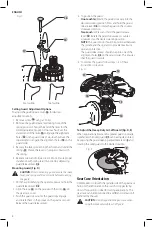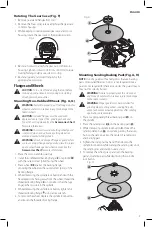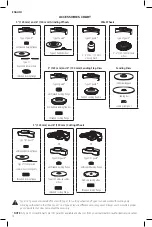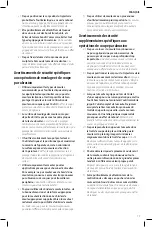
English
7
the switch will need to be cycled (turned off and then on)
to restart tool.
E-Clutch™
This unit is equipped with an E-Clutch™ (Electronic Clutch),
which in the event of a high-load or wheel pinch, the unit
will be shut off to reduce the reaction torque to the user.
The switch needs to be cycled (turned off and then on) to
restart tool.
Brake
When the switch is released the motor immediately turns
off and electronically brakes stopping the accessory quickly.
Kickback Brake™
When a pinch, stall, or bind-up event is sensed the
electronic brake engages with maximum force to quickly
stop the wheel, reduce the movement of the grinder, and
shut the grinder off. Turn the unit on to restart tool.
Constant Clutch™
When overloaded or stalled the motor torque is reduced. If
load is reduced the torque and RPM will increase. If the tool
is stalled for an extended amount of time it will shut-off and
require the switch to cycle to restart.
LED Indicator (Fig. A)
The LED indicator
7
will remain lit green during normal
activity, or blink in a pattern of red light to alert you a
tool protection feature has been activated. Refer to the
LED Guide
at the back of this manual for explanations of
blink patterns.
ASSEMBLY AND ADJUSTMENTS
WARNING: To reduce the risk of serious personal
injury, turn unit off and disconnect it from
power source before making any adjustments or
removing/installing attachments or accessories.
An accidental start-up can cause injury.
Accessories
The capacity of the slicer guard will only fit 6" (150 mm)
diameter x 1/16" (1.58 mm) thick T1 grinding wheels.
It is important to choose the correct guards, backing pads
and flanges to use with grinder accessories. See page 14 for
information on choosing the correct accessories.
WARNING:
Handle and store all abrasive wheels
carefully to prevent damage from thermal shock, heat,
mechanical damage, etc. Store in a dry protected area
free from high humidity, freezing temperatures or
extreme temperature changes.
Attaching Side Handle (Fig. A)
WARNING:
Before using the tool, check that the
handle is tightened securely.
Screw the side handle
4
tightly into one of the holes on
either side of the gear case. The side handle should always
be used to maintain control of the tool at all times.
Guards
CAUTION: Guards must be used with all grinding
wheels, cutting wheels, sanding flap discs, wire
brushes, and wire wheels.
The tool may be used
without a guard only when sanding and surface
finishing with conventional sanding and surface
finishing diamond pads. Refer to Figure A to see
guards provided with the unit. Some applications may
require purchasing the correct guard from your local
dealer or authorized service center.
nOTE:
Edge grinding and cutting can be performed with
Type 27 wheels designed and specified for this purpose;
1/4" (6.35 mm) thick wheels are designed for surface
grinding while thinner Type 27 wheels need to be examined
for the manufacturer's label to see if they can be used for
surface grinding or only edge grinding/cutting. A Type 1
guard must be used for any wheel where surface grinding
is forbidden. Cutting can also be performed by using a
Type 41 wheel and a Type 1 guard.
nOTE:
See the
Accessories Chart
to select the proper guard
/ accessory combination.
Adjusting and Mounting Guard (Fig. A, C, D)
CAUTION:
Turn unit off and unplug the tool before
making any adjustments or removing or installing
attachments or accessories.
CAUTION:
BEFORE operating the tool, identify which
guard adjustment option your tool is set to.
Adjustment Options
For guard adjustment, the guard release lever
15
engages
one of the alignment holes
13
on the guard collar using
a ratcheting feature. Your grinder offers two options for
this adjustment.
•
One-touch
TM
:
In this position the engaging face
is slanted and will ride over to the next alignment
hole when guard is rotated in a clockwise direction
(spindle facing user) but self-locks in the counter-
clockwise direction.
•
Two-touch
TM
:
In this position the engaging face is
straight and squared off. It will NOT ride over to the next
alignment hole unless guard release lever is pressed and
held while simultaneously rotating the guard in either
a clockwise or counter-clockwise direction (spindle
facing user).










































